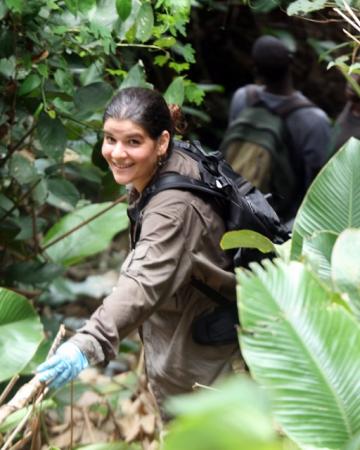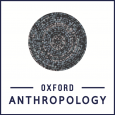Professor Susana Carvalho

Primate Models for Behavioural Evolution Lab
Research interests: Chimpanzee behaviour (especially tool use, material culture), primate archaeology; origins and evolution of technology, archaeology of East African Pliocene, novel methods for primatological/archaeological data collection and analyses.
Background
I am a primatologist and palaeoanthropologist. I was one of main founders of the field of Primate Archaeology. I have been studying stone tool use by wild chimpanzees in Bossou, Guinea, West Africa, since 2006, and carrying archaeological research in the Koobi Fora area, Kenya, East Africa since 2008, with a current focus on the archaeology of the Pliocene. I am the director of the Paleo-Primate Project Gorongosa since 2015, where an international team of 20 senior researchers is carrying an unprecedented interdisciplinary approach to understanding hominin origins and adaptations. In Mozambique, I am focusing on extant primates (baboons vervets) as models for behavioural evolution, and I am also directing surveys, excavations of fossil sites, and actualistic experimentations to achieve a more holistic understanding of our past evolution.
I received a BA in Archaeology from Oporto University (1997), then a MSc in Human Evolution from Coimbra University (2007), after having worked some years in between in municipal archaeology. My PhD in Biological Anthropology from Cambridge (2013) focused on living primates as behavioural models for the origins of technology. I held a Junior Research Fellowship at Clare Hall, Cambridge, and had postdoctoral positions at Oxford and at the Center for the Advanced Study of Human Paleobiology, George Washington University, USA. I joined the University of Oxford in 2015, as Associate Professor of Palaeoanthropology and Fellow of St. Hugh’s College, since becoming Professor of Palaeoanthropology in 2021.
I am a Primatologist and Paleoanthropologist interested in the evolution of behaviour and in using extant primates as models for our early hominin records. I have carried long term work with wild chimpanzees and baboons in Africa, and i have been pivotal in the broadening of archaeology to include non-human records AND earlier Pliocene records. I am one of the founders of the field of primate archaeology. I have projects in East Africa (Kenya) and West Africa (Guinea). In 2015 I started a fantastic endeavour as Director of Paleontology and Primatology in Gorongosa National Park, Mozambique, leading the Paleo-Primate Project. In 2016 I founded the Primate Models for Behavioural Evolution Lab, at the Institute of Cognitive and Evolutionary Anthropology, where we now host ca.15 researchers! In 2018, I started the Oxford-Gorongosa Paleo-Primate Field School, a unique opportunity for students to get multidisciplinary field training in animal behaviour and paleoanthropology. I teach PG seminars in Principles of Evolution and Behaviour, UG lectures in Human Evolution, Behavioural Evolution and Primatology, and provide practicals on hominin evolution.
Current student in another Department: Lynn Lewis-Bevan (Zoology)
2018
Habermann J., Alberti, M., Aldeias V., Alemseged Z., Archer W., Bamford M., Biro D., Braun D.R., Capelli C., Cunha E., Ferreira da Silva M.J., Luedecke T., Madiquida H., Martinez F., Mathe J., Negash E., Paulo L.M., Pinto M., Stalmans M., Tatá F., Wynn J., Bobe R., Carvalho S. (2018). Gorongosa by the sea: first fossil sites from the Urema Rift and their coastal paleoenvironmental and paleoecological contexts. Palaeogeography, Palaeoclimatology, Palaeoecology. Online early view.
Mendonça R., Dahl C., Carvalho S., Matsuzawa T., Adachi I. (2018). Clear prosocial choice by chimpanzees (Pan troglodytes) and its social determinants. PeerJ 6:e5315; DOI 10.7717/peerj.5315.
Tibble L. & Carvalho S. (In press, 2018). Rethinking the evolution of property and possession: A review and methodological proposition. Evolutionary Anthropology, 1-12.
2017
Campbell R. and Carvalho. S. (2017). Tool use and manufacture in the last common ancestor of Pan and Homo. In: Muller M., Wrangham R., Pilbeam D. (Eds.), Chimpanzees and Human Evolution. Harvard University Press. ISBN 9780674967953. Pp. 602-644.
2015
Hockings J.K., Bryson-Morrison N., Carvalho S., Fujisawa M., Humle T., McGrew W., Nakamura M., Ohashi G., Yamanashi Y., Yamakoshi G., Matsuzawa T. Tools to tipple: Ethanol ingestion by wild chimpanzees using leaf-sponges. Royal Society Open Sci2: 150150.
Benito-Calvo A., Carvalho S., Arroyo A., Matsuzawa T., de la Torre I. First GIS analysis of modern stone tools used by wild chimpanzees in Bossou, Guinea, West Africa. PLoS ONE 10: e0121613.
Hockings K., McLennan M., Carvalho S., Ancrenaz M., Bobe R., Byrne R., Dunbar R., Matsuzawa T., McGrew W., Wood B., Wrangham R., Hill C. Apes in the Anthropocene: Adaptation & Survival. Trends in Ecology and Evolution, 30: 215-222.
2014
Caruana M., Carvalho S., Braun D., Presnyakova D., Haslam M., Archer W., Bobe R., Harris J. Quantifying traces of tool use: A novel morphometric analysis of damage patterns on percussive tools. PLoS ONE 9: e113856.
2013
Haslam M., Gumert M., Biro D., Carvalho S., Malaivijitnond S. (2013). Use-Wear patterns on wild macaque stone tools reveal their behavioural history. PLoS ONE 8(8): e72872.
Carvalho S., Matsuzawa T., McGrew W. (2013). From pounding to knapping: How living apes can help us model hominin lithics. In: C. Sanz, J. Call, C. Boesch (Eds.). Tool Use in Animals: Cognition and Ecology. Cambridge University Press. Pp. 225-241.
2012
Carvalho S., Biro D., Cunha E., Hockings K., McGrew W., Richmond B., Matsuzawa T. (2012). Chimpanzee carrying behavior and the origins of human bipedality. Current Biology 22: R180-181.
Carvalho S., McGrew W. (2012) The origins of the Oldowan: Why chimpanzees (Pan troglodytes) still are good models for technological evolution in Africa. In: Domínguez-Rodrigo, M. (Ed.) Stone Tools and Fossil Bones: Debates in the Archaeology of Human Origins. Cambridge University Press. Pp.222-244.
Hockings K., Humle T., Carvalho S., Matsuzawa T. (2012) Chimpanzee interactions with other species in an anthropogenic habitat. Behaviour 149: 299-324.
2011
Carvalho S. (2011) Extensive surveys of chimpanzee stone tools: From the telescope to the magnifying glass. In: Matsuzawa T., Humle T., Sugiyama Y. (Eds.) The Chimpanzees of Bossou and Nimba.Springer, Tokyo. Pp. 145-156.
2010
Biro D., Carvalho S., Matsuzawa T. (2010) Tools, traditions and technologies: Interdisciplinary approaches to chimpanzee nut-cracking. In: Lonsdorf E., Ross S., Matsuzawa T. (Eds.) The Mind of the Chimpanzee: Ecological and Experimental Perspectives. University of Chicago Press, Chicago. Pp.141-155.
2009
Carvalho S., Biro D., McGrew W., Matsuzawa T. (2009) Tool-composite reuse in wild chimpanzees (Pan troglodytes): Archaeologically invisible steps in the technological evolution of early hominins? Animal Cognition 12: 103-114.
Haslam M., Hernandez-Aguílar A., Ling V., Carvalho S., de la Torre I., De Stefano A., Du A., Hardy B., Harris J.W.K., Marchant L., Matsuzawa T., McGrew W., Mercader J., Mora R., Petraglia M., Roche H., Stout D., Visalberghi E., Warren R. (2009) Primate archaeology. Nature 460: 339-444.
2008
Carvalho S., Cunha E., Sousa C., Matsuzawa T. (2008) Chaînes opératoires and resource exploitation strategies in chimpanzee nut-cracking (Pan troglodytes). Journal of Human Evolution 55: 148-163.



